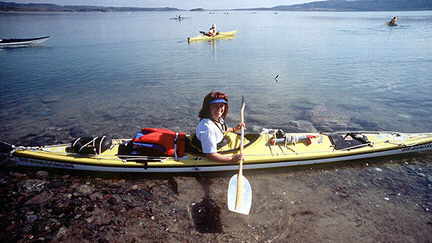Teresa Davey & Phil Hossack
Victoria Jason had a dream, one she saw come to life.

The Winnipeg grandmother was the first woman to kayak the Northwest Passage starting in the summer of 1991, and completing her odyssey alone in 1994.
Her award winning first book Kabloona in the Yellow Kayak [Reviewed in the Winter 1997 issue of Qayaq.] chronicles the experience of her 7500-km journey over four summer seasons it took to complete the voyage. She began a second volume titled Kabloona Returns – Arctic Summers in Pelly Bay, which was to be published this year.
She found the Arctic to be exhilarating and fell in love with the history and people of the north. Writing of her experience Victoria said, “I had fallen in love with the Arctic and wanted above all else to return.”
In 1996 she returned to the hamlet of Pelly Bay, Nunavut (now Kugaaruk), welcomed by swarms of children asking questions about her kayak Windsong, each wanting and then getting a turn paddling the craft. When she questioned locals about why the kids were playing basketball instead of paddling kayaks, a new partnership emerged.
In 1997 Victoria and Michael Hart, then manager of the Koomiut Co-op in the hamlet purchased and brought four new Current Designs kayaks to the community. Instead of learning about their heritage from books in the school library each child in the hamlet had the opportunity to paddle a kayak on the waters of Pelly Bay. Young and old waited for their turn to try what was once their tradition.
The reintroduction of kayaking blossomed. Local guides were trained, a fleet of kayaks obtained and the paddling season of 1998 saw the first ever tourists arrive in the hamlet. They arrived to travel with the first Inuit-guided sea kayak tours. Paddling out of Pelly Bay, the group enjoyed the spectacular landscape, and an area rich in history and tradition.

Early in 1999 Victoria was diagnosed with a brain tumor. Surgery and chemotherapy left her unable physically to participate in further northern sojourns. She passed away in May 2000 at the age of 55.
Inukshuks stood sentinel as guideposts on the hills and the aroma of Arctic Heather filled the breeze last summer as Victoria’s daughters Angie, Debbie and Teresa returned their mother to the north that had captured her soul.
The sisters kayaked part of the route that brought Victoria to Pelly Bay. At one of Victoria’s favourite campsites, the Isuqtuk river drains into the Arctic Ocean. The stone fish weirs nearby speak of the Inuit history on the land. There they unveiled a plaque erected by the Inuit community in their mother’s memory.
The daughters drank from a waterfall at Qutairrurjaq, another of their mother’s campsites. They visited the summer camp of Indigo Kukkuvak and his wife Maria. There, in a tent ring left where Victoria had placed it, they built an inukshuk facing into the north wind she loved to feel on her face.
In each of these special places they spread her ashes while singing You are my Sunshine, a song those who paddled with Victoria will remember echoing across the water.
Even after her passing, the seed of Victoria’s dream has germinated. Children can paddle on the waters of the bay and hamlet elders participate in a programme of kayak building, stretching synthetic skins over traditional frame kayaks. The initial season in 1998 saw the successful arrival of the first tourists in the Arctic Hamlet, Victoria and three Inuit guided the group of Americans and Canadians on a weeklong kayak tour on Pelly Bay itself.
But since 1999 no tourists arrive.
In an interesting turn of events her youngest daughter Teresa Davey and partner Phil Hossack have teamed up with the Koomiut Co-op in Kugaaruk. The embryo of an arctic touring company with Inuit guides from Pelly Bay will be restarted with their help. Encouraged with support from the community, they are welcoming the challenge. Both have strong paddling backgrounds and teach sea kayaking skills for the University of Manitoba in Winnipeg. Phil paddled with Victoria often and spent the 1998 season with her paddling on Pelly Bay.
To facilitate the venture, they will promote tours and bookings from their homes in Winnipeg, and accompany the guides for the initial paddling seasons. Their long-term goal is to leave the Hamlet of Kugaaruk with it’s own locally operated and guided touring company.
Equipment and people in Kugaaruk are ready and willing; they also hope to continue Victoria’s practice of reacquainting the community with the kayak through teaching the children first hand about the kayak.
Victoria’s dream continues to grow.
